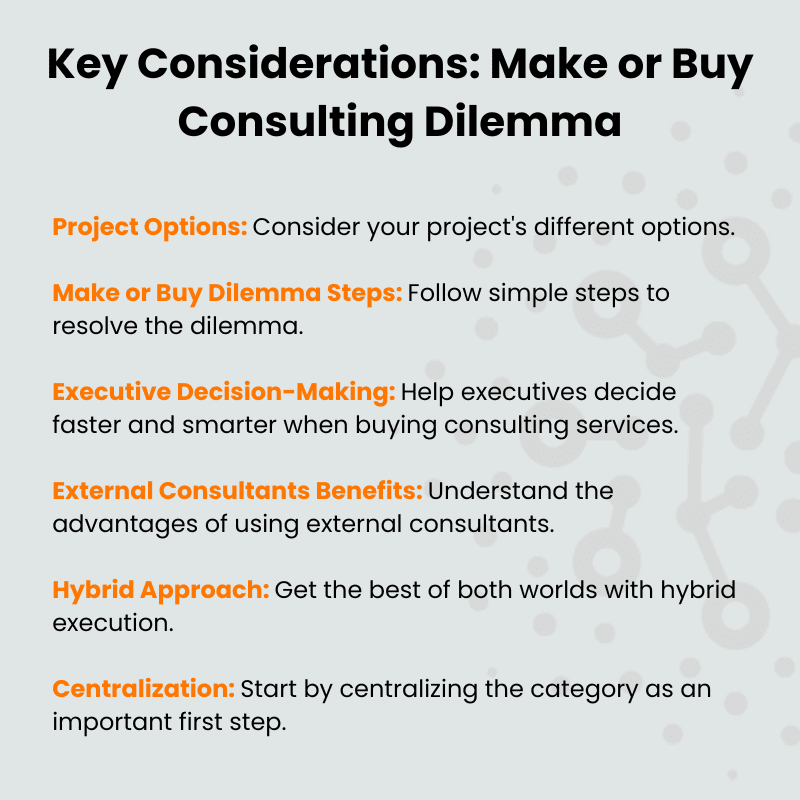The age-old dilemma of whether to “make” or “buy” consulting services remains a pivotal challenge in the ever-evolving world of business, where success often hinges on the ability to make crucial decisions.
This conundrum requires organizations to navigate a complex landscape where the choice between utilizing internal resources or seeking external expertise can significantly impact project outcomes, budgets, and strategic alignment.
As Peter F. Drucker wisely noted, “Whenever you see a successful business, someone has made a courageous decision.”
The decision to opt for internal capabilities or external consulting services demands more than mere courage; it necessitates a deep understanding of the benefits inherent to each approach. It’s a decision that can shape the trajectory of a project and, ultimately, the organization itself.
Join us as we unravel the complexities, equip you with practical insights, and empower you to make well-informed decisions that align with your organization’s strategy and goals.
1. What Are the Different Options for Your Project?
Launching a project with Internal resources is top of mind for any executive. It means keeping the costs at a minimum and optimizing the use of your internal skills and resources.
But this option can very quickly reach its limits if the project team is not given the appropriate time and responsibilities to lead the project efficiently.
Moreover, because the leaders of internal projects are often high-potentials on the leadership fast track, they find it challenging to push boundaries and confront the more established leaders and influencers who hold the key to their careers.
Assigning an independent task force can bring focus, speed, and pressure to the table, which is sometimes enough for the success of a project.
2. Simple Steps to Solve the Make or Buy Dilemma
Most companies and their procurement function work to optimize their external spend and their pool of suppliers to better support the overall strategy. They have developed methods for answering a variety of difficult questions:
- What are the key activities that can be outsourced?
- What does the pool of potential suppliers look like?
- How mature is the market for suppliers?
- What providers are appropriate for us?
- Is it worth it to outsource a particular activity for the long term?
The same questions apply to Consulting Procurement. Unfortunately, most companies have neither the experience nor the methods to answer them.
Yet, today, all leaders throughout an organization, from the head of procurement to senior executives responsible for signing off on major consulting projects, are expected to align their activities with the overall strategy of the enterprise.
3. Helping Executives Make Faster and Smarter Decisions When Buying Consulting Services
When it comes to making decisions about consultants, executives often fall back on word of mouth, on perceptions of the reputations of various providers, and on the fancy claims of the consultants themselves.
Also, they take the line of least resistance and simply hire the consultants they have used in the past, regardless of whether those consultants are the most appropriate for a particular project or for furthering the broader strategy of the company.
These leaders have no reliable way to determine whether a particular consultant precisely meets the company’s needs, no way to gauge a consultant’s likely level of performance, and no benchmarks against which to compare providers.
And until they avail themselves of an independent, credible means of assessing providers and matching them to their company’s needs, they are likely to lag their competitors who have.

4. Advantages of Using External Consultants
Because they are very familiar with the problem, these Consultants can usually solve it more efficiently and at less cost than Internal resources.
They can also make up for lack of internal resources and flexibility that prevents internal personnel from being diverted from their regular jobs.
Clients may also want to use consultants for broader purposes than the project itself. These could include training of executives on new skills, introducing external change agents, learning best practices in the industry or a capability, exposing the organization to a fresh perspective, or relying on the stamp of a recognized consulting brand to reassure board members or investors.
But even under those conditions, hiring external consultants is not always the best solution. For example, consulting services that meet your needs may not be available in your industry or your country.
On the other hand, leading an internal project can be tricky. The internal team may be unaware of the latest trends in the industry or capability.
They may waste time reinventing already well-established improvement methodologies, resulting in longer projects and higher overall costs. Again, the fact that the team members are part of the company can make it difficult to disrupt the established order.
5. Hybrid Execution – The Best of Both Worlds
Sometimes, the path to achieving optimal performance lies in a middle ground—a hybrid execution that combines the strengths of both internal and external resources. By adopting this approach, organizations can harness the best of both worlds.
Consider breaking down your project into distinct workstreams, each with its unique characteristics. Identify elements that can be outsourced without compromising confidentiality or service availability. These stand-alone workstreams can then be entrusted to external consultants.
Meanwhile, crucial aspects that demand in-house control and expertise can be retained. Under the guidance of a highly experienced project leader, your organization can continue to manage and execute these components internally.
The hybrid execution model allows for a strategic allocation of resources, leveraging external consultants where their specialized skills shine while maintaining internal oversight where it matters most.
This balanced approach optimizes performance and ensures a seamless project execution, ultimately delivering the best possible outcomes.
6. Centralizing the Category as an Important Initial Step
It’s critical to be able to monitor your budget, and centralizing the Category will provide that capability. Some companies have responded to what is mostly a ‘Make or buy’ dilemma by centralizing Consulting procurement.
The aim is to have a more global vision of consulting efforts, better understanding of the costs, and more powerful levers for negotiating volume discounts and creating synergies across functions and business units.
Recognizing that Consulting is an accelerator of change, these companies make Consulting Management the responsibility of the head of Strategy or a Transformation leader. Generally, putting the accountability of the Consulting Budget and, therefore, the monitoring of the Consulting Expenses, close to the group in charge of the Strategy, is the right move.
This team needs to define what are the rules when procuring Consulting Services. Demand management, Make or Buy strategy, and Consulting Spend analysis should go through them to ensure alignment with the overall strategy and their consistency across the board.
Conclusion: A Strategic Approach to Consulting Decision-Making
We can all agree that the make or buy decision in consulting emerges as a pivotal juncture. However, it is not a one-size-fits-all puzzle but rather a nuanced challenge, demanding astute consideration.
We must remind ourselves that every organization possesses its unique DNA. Decisions hinge on the composition of your people—your internal talents, the presence or absence of an internal consulting group, and the specific skills residing within your workforce. It is a decision deeply rooted in your organizational context.
Moreover, at its core, this decision should relentlessly focus on value. There are instances where collaborating with external consultants yields the utmost value, irrespective of your internal resources.
Their expertise, fresh perspective, and specialized knowledge can be invaluable assets. Conversely, there are scenarios where working with internal resources ensures data confidentiality, mitigates risks, and maximizes the value created.
In this labyrinth of choices, we urge you to be smart, practical, and contemplative. Pause, assess, and strategize before acting. Understand that the best solution for your organization emerges from the interplay of your unique circumstances and your unyielding commitment to maximizing value.
So, as you embark on this journey of consulting decision-making, remember that your path is singular, and your choices, judicious.
The decision to make or buy is not just a choice; it’s a strategic opportunity to shape your organization’s future.
Be courageous, be discerning, and always seek the path that leads to the highest value—a future brimming with success and strategic alignment in the ever-evolving world of business.
make or buy make or buy make or buy make or buy make or buy
make or buy make or buy make or buy make or buy make or buy
make or buy make or buy make or buy make or buy make or buy

How Consource Can Help?
When choosing between your in-house team and external experts, it can be a tough call. But with Consource, you’ve the power to ask the right questions in the demand module, tailored to your priorities and team strengths. This way, you can tackle the make-or-buy decision strategically, treating consulting as a smart investment in line with your goals.








0 Comments